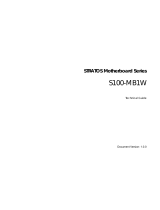
- 19 -
values, especially for the LAN MAC. If you enter the wrong LAN MAC, IPMI View will not be able to
connect to that system any more.
If you accidentally enter a wrong LAN MAC value, you may use the IPnMAC.exe command in the
IPMI Solution/Utility subfolder on this CD to update it. To activate IPnMAC.exe,,which is a DOS
command, you must first boot your managed system to DOS, and then execute IPnMAC.exe on the
managed system.
• SNMP
This shows the SNMP trap configuration of the system needing to receive the SNMP traps generated by
the BMC and allows you to modify them. To change the configuration on the BMC, type in the SNMP
community name in the Community text field and the IP address and MAC address in the SNMP Trap
Receivers table in the SNMP group, and then click the Update button.
The SNMP Trap may have multiple destinations. When any critical error occurs, an SNMP trap packet
will be sent to all receivers in the list. To remove an SNMP receiver, you may change both IP and MAC
addresses to 0.0.0.0 and 00:00:00:00:00:00 respectively, and then click Update.
On the system receiving the SNMP traps, an SNMP trap receiver software needs to be installed and run.
The managed system will send out an SNMP trap packet to receivers at the moment the event occurs. If
an SNMP trap receiver is not running, the trap packet is discarded and won’t be queued anywhere.
• RS232 / MODEM (Only available for IPMI 1.5)
This shows the configuration of the RS232 interface on the BMC. It is used to initialize the RS232 port
and the installed modem, if any. The RS232 port is the box-header (Figure 7-2) on the BMC and is a
dedicated serial port.
Baud Rate: the baud rate for serial connections (does not affect paging settings).
Modem Init String: the modem initialization string for serial connections (does not affect paging
settings).
Figure 7-2





















